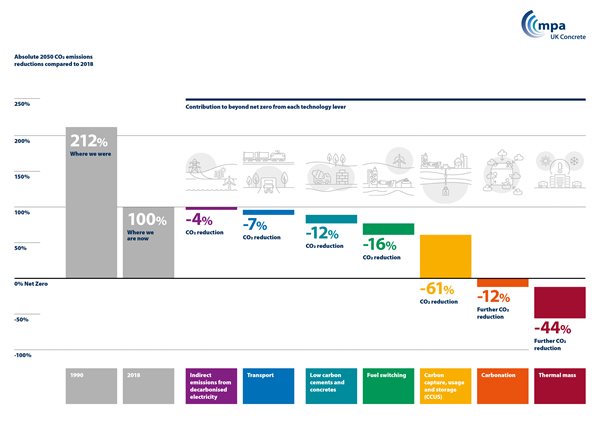Our Roadmap to Beyond Net Zero
In October 2020, the UK Concrete and Cement industry published its Beyond Net Zero roadmap. The roadmap provides a pathway to beyond net zero with an achievable and viable route that uses seven key decarbonisation technology levers. Download the Roadmap to Beyond Net Zero
Net zero can be met through a blend of these levers, which include decarbonised electricity and transport networks, fuel switching, greater use of low-carbon cements and concretes, as well as advanced carbon capture technology. Many of these levers are already proven technologies, while others will require collaboration and input from more than one industry. Most will need to be supported by local and central Government over the long term, and critically all will require concerted action and investment.
At this stage, the roadmap represents our best course for achieving and going beyond net zero. However, as we approach 2050 it may prove to be the case that we can dial up or down certain levers depending on our progress.

The first five of these technology levers focus on production related emissions:
- Indirect emissions reduction from decarbonised electricity: a decarbonised electricity grid can facilitate the adoption of new technologies that require electrical power, such as carbon capture and electrical heat – including from plasma energy. Artificial intelligence (AI) and automation, will also deliver further operational efficiencies in concrete and cement plants.
- Decarbonised transport networks: the industry has already increased its use of rail freight, a much greener mode of transport than road, where it is possible. By moving away from petrol and diesel vehicles, investing in new fleet, and reducing road transport miles, carbon emissions can be removed from delivery transport.
- Low carbon cements and concretes: concrete mixes with innovative low-emission constituents will be enabled by revisions to product and building standards, which in turn will encourage wider adoption of their use across the built environment. Additional R&D into alternative cement formulations and binders will further reduce emissions. Read more
- Fuel switching: continuing to replace fossil fuels with alternatives will deliver significant savings – for example, our roadmap estimates that where available biomass wastes can generate over 70% of the heat used for cement production. Further research, investment and supportive infrastructure will enable the use of hydrogen, plasma or other new heating technologies. Read more
- Carbon capture, usage and storage (CCUS): this technology, which allows CO2 emissions to be captured and either locked up in long-term storage or used in other industrial processes, represents the most significant technological shift in the roadmap, with the potential to make the greatest CO2 reduction in the roadmap.Read more
Going beyond net zero will be achieved by using on-site carbon capture and by maximising the natural, in-use properties of concrete which include:
- Carbonation: the natural process where concrete absorbs CO2 from the atmosphere throughout its lifetime and at end of life, storing it permanently as a carbon sink. Read more
- Thermal mass: the property of heavyweight materials like concrete and masonry where heat can be absorbed, stored and released slowly. Buildings with high thermal mass generally have lower energy requirements for heating and cooling and active thermal mass management can help to lessen the demand on energy grids. Read more
For us to get to net zero and beyond, we understand that significant technological, structural and behavioural changes are required by our industry, clients, and specifiers of construction materials across buildings and infrastructure – as well as investment and buy in from Government.
For more information:
- Download the UK Concrete and Cement Roadmap to Beyond Net Zero
- Download the technology lever briefing on Carbon Capture, Usage and Storage (CCUS)